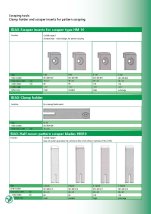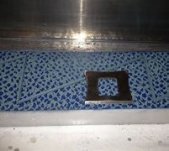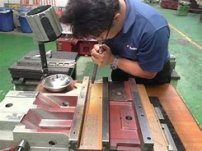How to install the app on iOS
Follow along with the video below to see how to install our site as a web app on your home screen.
Note: This feature may not be available in some browsers.
You are using an out of date browser. It may not display this or other websites correctly.
You should upgrade or use an alternative browser.
You should upgrade or use an alternative browser.
Biax blade sharpening question
- Thread starter Nickki
- Start date
- Replies 11
- Views 1,658
Richard King
Diamond
- Joined
- Jul 12, 2005
- Location
- Cottage Grove, MN 55016
The flatter the rake the harder the material. I think they say 3 to 5 because it is not something you need to check on an optical comparator to get a perfect 5 degree's. A Glendo lapper has a scale that you eyeball. If you scrape plastic like Rulon they tell you to grind it - 20 to 30 degrees. Scraping steels with a power scraper we recommend + 20 to 30 degree's
Last edited:
Dear Mr. KingThe flatter the rake the harder the material. I think they say 3 to 5 because it is not something you need to check on an optical comparator to get a perfect 5 degree's. A Glendo lapper has a scale that you eyeball. If you scrape plastic like Rulon they tell you to grind it - 20 to 30 degrees. Scraping steels with a power scraper we recommend + 20 to 30 degree's
What about half-moon carbide blade relief angle? The Catalog mentioned -3.5 degree for insert and nothing for blades, but I measure it at about -6 degree.
I have read that you recommend half-moon blades for Turcite/Rulon power scraping but with -12 degree relief angle.
Do you mean to use that modified half-moon blades ( -12 degree) with BL40/BL10/BS40 for Turcite scraping or you mean to use the modified half-moon blade with HM10 scraper to make oil pocket pattern only on plastics?
Could you explain more ?
Thanks
Attachments
Richard King
Diamond
- Joined
- Jul 12, 2005
- Location
- Cottage Grove, MN 55016
The top of the picture above those are Carbide tipped blade inserts that bolt onto the blade holder under them. They are good for box ways or large machines. The bottom of the page are also 1/2 moon blades that are designed to 1/2 moon in narrow dovetail ways. They come from the factory ground at Negative - 5 degree's tip rake. Biax Factory does not tell you how to sharpen those 1/2 moon blades for plastic (Rulon 142 or Turcite B type).
The rake angle is set on a scale that is set on a carbide grinder or lapper that we eyeball the angle. We do not use an optical comparator to measure the angle. If your off one degree or two, that's OK.
BIAX teaching or writes to use a long narrow 20 -150 or 15-150 blade ground at a 40 radius tip at - negative 20 to 30 rake. I used to follow those recommendations and was never happy using them. Biax never talked about using a Power Scraper to scrape the plastic, just hand scraping. 30 years ago BIAX made a 10" ( 254 mm) long blade they called the "Plastic blade" but it was discontinued because no one bought them. I have one and it is to flexible and doesn't work as good as the 1/2 moon blade in a 6" ~ 150mm long insert holder.
When I taught in Taiwan where they use a lot of turcite. (they call all brands turcite with a small T, It can be Rulon, Florawaway, Garlock or Rulon brands) We experimented over there grinding all the Biax Blades and inserts, flat, narrow, wide, 3" (75 mm) and 6" (150mm) long blades and we ad the best results using 1/2 moon with a 40 to 60 blade tip radius with a negative - 12 degree's rake.
In Taiwan we tested using the BIAX Power Scrapers on the turcite materials in the hundreds of classes we taught and we discovered that scraping turcite with a Power Scraper was to dangerous as many students were not careful enough to not get a DIG or corner scratch and ruin the turcite and we would have to pull of the new turcite and glue on new. So we recommended that they only scrape turcite by hand. The productivity or faster speed of power scraping the turcite was lost in the when they had to remove and replace the ruined turcite.
The rake angle is set on a scale that is set on a carbide grinder or lapper that we eyeball the angle. We do not use an optical comparator to measure the angle. If your off one degree or two, that's OK.
BIAX teaching or writes to use a long narrow 20 -150 or 15-150 blade ground at a 40 radius tip at - negative 20 to 30 rake. I used to follow those recommendations and was never happy using them. Biax never talked about using a Power Scraper to scrape the plastic, just hand scraping. 30 years ago BIAX made a 10" ( 254 mm) long blade they called the "Plastic blade" but it was discontinued because no one bought them. I have one and it is to flexible and doesn't work as good as the 1/2 moon blade in a 6" ~ 150mm long insert holder.
When I taught in Taiwan where they use a lot of turcite. (they call all brands turcite with a small T, It can be Rulon, Florawaway, Garlock or Rulon brands) We experimented over there grinding all the Biax Blades and inserts, flat, narrow, wide, 3" (75 mm) and 6" (150mm) long blades and we ad the best results using 1/2 moon with a 40 to 60 blade tip radius with a negative - 12 degree's rake.
In Taiwan we tested using the BIAX Power Scrapers on the turcite materials in the hundreds of classes we taught and we discovered that scraping turcite with a Power Scraper was to dangerous as many students were not careful enough to not get a DIG or corner scratch and ruin the turcite and we would have to pull of the new turcite and glue on new. So we recommended that they only scrape turcite by hand. The productivity or faster speed of power scraping the turcite was lost in the when they had to remove and replace the ruined turcite.
Richard King
Diamond
- Joined
- Jul 12, 2005
- Location
- Cottage Grove, MN 55016
Many students and rookie scrapers like digitalmg want to learn to scrape turcite with a power scraper. He private messaged me and he said he has large machines that he needs to replace the turcite and scrape it. It can be scraped with a power scraper if you are skilled to hold the BIAX Power scraper BL-10 or BL 40 (7ELM) and not get corner scratches or stay in one place to long and get a DIG hole. We DO NOT 1/2 moon turcite or use the HM-10 Power Flaker.
They way you begin the Power Scraper of turcite is to hold the back of the scraper lower then the blade tip so it doesn't cut into the material and start to move the head of the power scraper to the left or right in a pattern I call crosses or individual scrape marks. You use the same technique of scraping at a 45 degree angle to the way and your next pass or scrape after you have blued up the way is to stand at 90 degree's to scrape the next time. Same as Cast Iron scraping to get the checkerboard look. As you move the blade side to sside you slowly raise the back of the Power Scraper and as soon as it starts to cut into the turcite you stop raining it and that's where you hold it to power scrape it. A skilled operator can scrape turcite with a power scraper. I do not power scrape turcite or plastic. I hand scrape it using the blade tips and ground methods I describe above.
They way you begin the Power Scraper of turcite is to hold the back of the scraper lower then the blade tip so it doesn't cut into the material and start to move the head of the power scraper to the left or right in a pattern I call crosses or individual scrape marks. You use the same technique of scraping at a 45 degree angle to the way and your next pass or scrape after you have blued up the way is to stand at 90 degree's to scrape the next time. Same as Cast Iron scraping to get the checkerboard look. As you move the blade side to sside you slowly raise the back of the Power Scraper and as soon as it starts to cut into the turcite you stop raining it and that's where you hold it to power scrape it. A skilled operator can scrape turcite with a power scraper. I do not power scrape turcite or plastic. I hand scrape it using the blade tips and ground methods I describe above.
Richard King
Diamond
- Joined
- Jul 12, 2005
- Location
- Cottage Grove, MN 55016
Here is a link to a rebuild of a Kitamura machining center I put new Rulon 142 on.
Kitamura Mycenter Head Way Turcite Repair
For the last few days I have been rebuilding or repairing the Z headstock ways on a Kitamura Mycenter VMC. The owner operator Jay Simon of J.V. Machine Company - Part Production | Elko, MN a 2 man shop called me and asked if I was still rebuilding as I re-Ruloned another of his Kitamura's...
www.practicalmachinist.com
Richard King
Diamond
- Joined
- Jul 12, 2005
- Location
- Cottage Grove, MN 55016
Pictures L to R
1) Scraping 20 PPI (points per inch) done by my assistant teacher Ted at PMC (Taiwan Precision Machine Research Center). 2) Ted's VMC table he scraped and oil grooves. 3) The Biax 1/2 moon flaker blade on a hand scraper I used when scraping the saddle on a BIG VBM down in Oklahoma. 4) Ted pull scraping turcite in a female box way on a VMC saddle. You can increase the size of the pictures by pressing ctrl and the + buttons a few times after you click on each individual picture.
1) Scraping 20 PPI (points per inch) done by my assistant teacher Ted at PMC (Taiwan Precision Machine Research Center). 2) Ted's VMC table he scraped and oil grooves. 3) The Biax 1/2 moon flaker blade on a hand scraper I used when scraping the saddle on a BIG VBM down in Oklahoma. 4) Ted pull scraping turcite in a female box way on a VMC saddle. You can increase the size of the pictures by pressing ctrl and the + buttons a few times after you click on each individual picture.
Attachments
Last edited:
Richard King
Diamond
- Joined
- Jul 12, 2005
- Location
- Cottage Grove, MN 55016
Richard King
Diamond
- Joined
- Jul 12, 2005
- Location
- Cottage Grove, MN 55016
When you scrape turcite you measure the depth and it should be minimum of 002" (0.051mm) maximum of .004" (0.102mm) If it is lower then that the turcite wears to fast and no oil can spread out on the ways and you get stick slip. Yes turcite when loaded can get stick slip. Many machine manufacturers discover that on the Y axis of Machining Centers.
Richard King
Diamond
- Joined
- Jul 12, 2005
- Location
- Cottage Grove, MN 55016
I know some of the old folks think I'm bragging, for you new readers here is an award the Taiwan builders presented to me.
Pictures L to R 1) Tami President awarding me. 2) Taiwanese newspaper article about how I taught many of the presidents of the TAMI members 3) close up of the award
Pictures L to R 1) Tami President awarding me. 2) Taiwanese newspaper article about how I taught many of the presidents of the TAMI members 3) close up of the award
Attachments
Richard King
Diamond
- Joined
- Jul 12, 2005
- Location
- Cottage Grove, MN 55016
After you get the work flat by rough paint scraping to .001" flatness or your part is ground or machined to .001". One of the easiest things to do when scraping to get more points per 1 inch (PPI) is to look straight down at your work. See as Ted is pull scraping his scraper is straight down. If you have a hand scraper and you push scrape to get more then 20 PPI use a shorted more flexible hand scraper. Grind the blade to a 60 mm (2.5") tip radius with neg - 5 degree rake and 40 mm (1.5" radius with neg. rake of 5 degree's to get 40 PPI. Same technique when BIAX power scraping, hold the power scraper like your holding a puppy hand under it and hand holding the top front.Pictures L to R
My class room in Taiwan 2) Ted experimented scraping 40 PPI on turcite 3) Ted pull scraping the turcite - picture 2
Use the side motion at 45 degrees to the side of the way and get individual scrape marks and individual scrape lines (like soldiers lined up in a parade) to get the "checkerboard" look on the part. Not touching each other. If they touch you've dug a hole. No need to get all the blue each scrape when you start the above technique, just switch sides and scrape at 90 degree's from your last pass and scrape the high spots you missed. Over stoning will destroy the scraping. Stone to only remove the burr at the front of the scrape mark.,
Similar threads
- Replies
- 21
- Views
- 2K
- Replies
- 2
- Views
- 755
- Replies
- 11
- Views
- 934
- Replies
- 8
- Views
- 870
- Replies
- 35
- Views
- 2K













